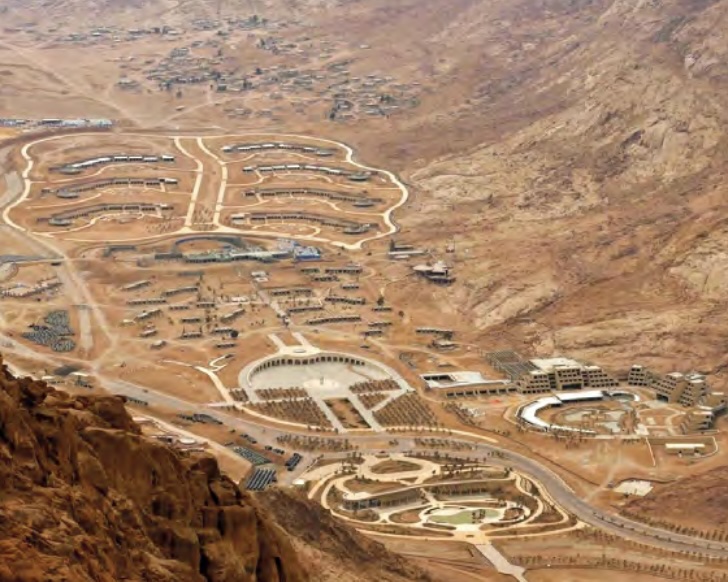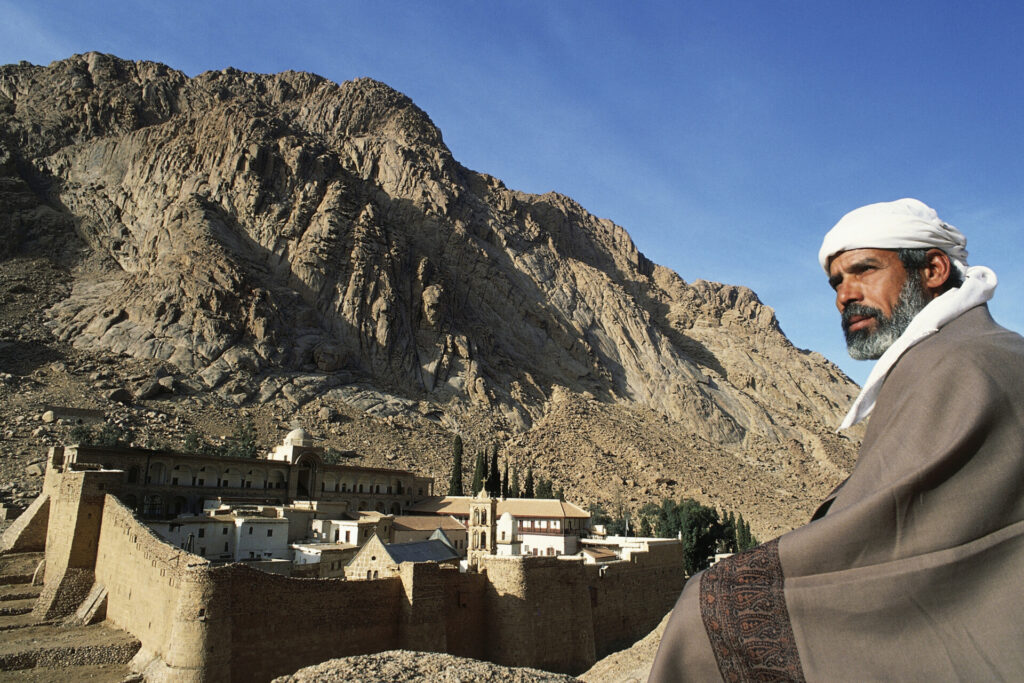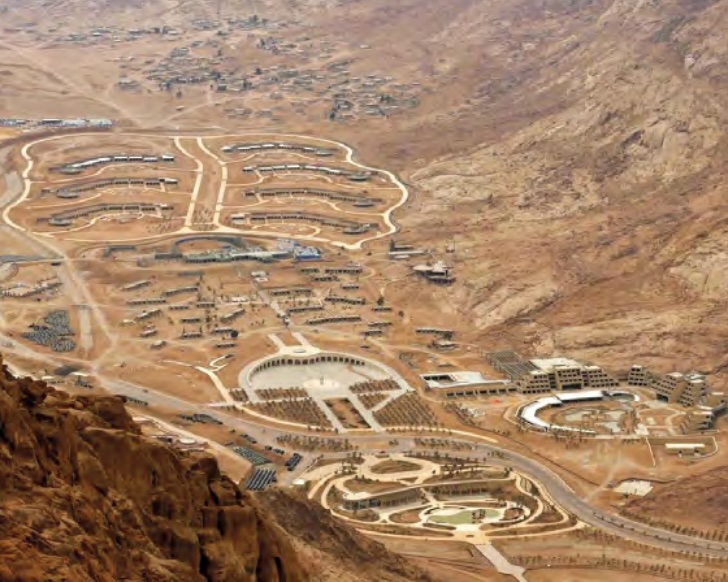Egypt’s Sinai Megaproject Is Erasing Bedouin Culture
The ‘Great Transfiguration Project’ promises tourists luxury in the sacred valley of St. Catherine, but locals say it’s destroying centuries of heritage and pushing people off their land.
Jessica Buxbaum is a Jerusalem-based journalist covering Israel’s occupation of Palestine and the Syrian Golan Heights, and Egypt’s Sinai Peninsula
June 17, 2025
Egypt’s Sinai Megaproject Is Erasing Bedouin Culture
A man sits in front of St. Catherine’s Monastery in Egypt’s Sinai Peninsula.
(DeAgostini/Getty Images)
Once a place of near-untouched desert sands nestled in the Sinai Peninsula’s mountains, Wadi al-Raha (“the Valley of Rest”), in the Egyptian town of St. Catherine, has now been transformed into a construction site.
Bulldozers, orange cones, piles of rubble and half-paved roads have become part of the iconic landscape since 2021, when Egypt’s Ministry of Housing, Utilities and Urban Communities began construction of the “Great Transfiguration Project” (GTP), a state-sponsored megatourism endeavor aiming to build five hotels, hundreds of villas, a 1.4-acre visitors’ center and a shopping complex in and around St. Catherine Protectorate, and expand the nearby airport. The area was declared a UNESCO World Heritage Site in 2002.
The GTP is set to be completed by October 2026. While the government is promoting it as “Egypt’s gift to the entire world and all religions,” both regional experts and the largely Bedouin community of St. Catherine claim it is irrevocably damaging this cultural and religious landmark.
“I call it the ‘Grand Disfiguration Project,’” John Grainger, the former manager of the European Union project to develop the protectorate, told New Lines.
St. Catherine is known for Mount Sinai, revered in Islam, Christianity and Judaism as the site where Moses received the Ten Commandments. The world’s oldest continuously functioning monastery sits at the mountain’s base. For centuries, pilgrims have flocked to St. Catherine’s Monastery, where early Christian manuscripts and artifacts are held. The Bedouin Jebeleya tribe (whose name literally means “people of the mountain” in Arabic) are considered the monastery’s ancient guardians, having arrived as Roman Christian soldiers sent by the Emperor Justinian in 529 to protect the monks in what was then the ruler’s newly built monastery. Today, the Jebeleya are predominantly Muslim and often work as guides to the monastery and surrounding mountains.

Construction for the GTP began swiftly and without warning for residents and the monastery — immediately threatening the Jebeleya’s quiet, rural lifestyle. “Some 3,000 construction workers were brought in,” a St. Catherine resident said, speaking on condition of anonymity. “People here were not prepared for this at all, and the fate of personal property that falls in the way of this construction remains unclear. Assurances and fake promises change day by day.”
When St. Catherine was granted its UNESCO world heritage status, the decision was accompanied by a demand that Egypt implement a sustainable development plan to protect the renowned vista, often depicted in literature and art, of the monastery cradled in the shadows of Mount Sinai against Wadi al-Raha. Despite repeated requests, Egypt still hasn’t filed a sustainable management plan for St. Catherine to UNESCO.
“The project is in total contravention of not only [Egypt’s] protectorate law, which requires an environmental impact statement to do anything, but also […] their commitments to the World Heritage Convention,” said Grainger, the former EU official.
The UNESCO World Heritage Committee called on Egypt to immediately halt construction in St. Catherine during its 2023 session. The committee also requested that a UNESCO-backed monitoring mission visit St. Catherine to assess the site. This still has not occurred, despite UNESCO having an office in Cairo.
World Heritage Watch, an organization promoting the preservation of UNESCO World Heritage sites, is campaigning for this mission in order to determine whether St. Catherine should be added to the UNESCO List of World Heritage in Danger. World Heritage sites are only discussed at committee sessions every two years, unless they are endangered, in which case they are on the agenda annually. “That gives the country two more years to create facts and two more years to play with UNESCO,” Stephan Doempke, chair of World Heritage Watch, told New Lines. “UNESCO has few possibilities to act as long as a site is not on the List of World Heritage in Danger.”
Heritage experts are increasingly concerned as Khaled el‑Enany, Egypt’s former minister of tourism and antiquities, is now vying for the position of UNESCO’s director-general. “If that happens, St. Catherine can be systematically kept off the agenda, swept under the table, and it will probably seal its fate,” Ben Hoffler, co-founder of the Bedouin Trail, an initiative of Bedouin-created hiking trails traversing Jordan and Egypt, told New Lines. “The Egyptian government is pulling all of these strings to push [the GTP] through with minimal criticism.”
UNESCO did not respond to interview requests from New Lines.
Egypt has been on a demolition spree in recent years, seeking to modernize the country’s metropolitan areas with expanded highways, residential towers and high-rise shopping malls at the expense of lower-income neighborhoods. Developments have displaced hundreds of thousands of families and desecrated historic tombs. Critics have slammed these urban renewal efforts as erasing Egypt’s iconic architectural past. Yet the government sees them as vital in boosting Egypt’s tourism sector. The state aims to attract 30 million tourists annually by 2028, and razing slums and upgrading tourist sites is part of its strategy to enhance the country’s aesthetic appeal.
A streak of building demolitions took place at the GTP’s onset in 2021, the largest occurring at the centuries-old Jebeleya cemetery. The Jebeleya tribe spent days after the demolition collecting the remains of several hundred relatives and moving them to a graveyard 6 miles outside of St. Catherine. The cemetery was then paved over and turned into a parking lot. “[The Jebeleya’s] homes are being demolished without compensation. Part of their mosque has been demolished. The cemetery has been dug up,” an expert on St. Catherine said, again speaking on condition of anonymity.
A sophisticated network of surveillance and intimidation by the Egyptian authorities has pushed nearly all local voices opposing the GTP into only speaking anonymously or declining to go on the record at all.
“If they say anything about it, they get a knock on the door [from Egyptian security services],” said Hoffler, who is also a former resident of St. Catherine. “The secret police in St. Catherine monitor everything so closely — phone calls, we’ve had spyware on telephones. They follow people literally in the street. I’ve been followed many times.”
Hoffler explained that as local protest is muzzled, the community itself is being erased. “Huge new complexes of resorts and villas have been built in front of existing Bedouin hamlets,” Hoffler said, noting the small neighborhood of Abu Zeituna, made up of approximately 20 homes on the outskirts of St. Catherine. “All of those houses have now been obscured behind one of the new villa developments of the Great Transfiguration Project,” Hoffler said. “The character of that settlement has changed.
Years of construction have ruptured the serene wilderness of St. Catherine. “Everyone’s face looks concerned,” an anonymous St. Catherine resident said. “They watch their landscape change, many trees in the way of construction are removed carelessly, old olives and pistachios were dug up and thrown aside.”
As the GTP transforms the environment, concerns are growing that it could also change St. Catherine’s demography. Hoffler warns the new hotels will likely only employ Nile Valley Egyptians instead of the local Bedouins, a trend seen across the hospitality industry in Sinai. “The town that has been a Bedouin-majority region for many centuries will soon become one where the majority of people are from mainland Egypt. And the Bedouin will become a minority in their own tribal territory,” Hoffler said.
With the possibility looming that St. Catherine’s tourism industry may soon be staffed by non-Bedouin Egyptians, locals long dependent on the area’s hiking tourism are already struggling.
Egypt’s first long-distance hiking routes, the Sinai and Red Sea Mountain trails, part of the transcontinental Bedouin Trail project, shut down in November 2024, primarily because state authorities stopped granting permits to enter these trails. “Permits for trips on Egypt’s long-distance trails are now unobtainable, which is one principal reason they’ve closed,” said Hoffler. “Our organizations suffered years of serious harassment from Egypt’s secret police. [They] suffered regular intimidation and at some points were detained and threatened with jail if any trips were to run on the trails.” Other adventure groups have also been forced to cancel their races or trips after the Egyptian government denied access to these routes.
A source told New Lines, on condition of anonymity, that the government resumed permits for one-day trips in April, surmising that the decision was because of the GTP and the expected influx of tourists. Yet even single-day permits are still restrictive for local trekking guides, when summit destinations in Sinai often take days to complete. “All around St. Catherine, you cannot hike, you cannot do anything. You can only climb [Mount] Sinai,” the anonymous source said, referring to the famous sunrise hike to Mount Sinai.
With the shuttering of these trails and denial of overnight permits, Bedouin guides have been pushed into illegal types of work in Sinai, further threatening their livelihoods.
“This kind of tourism does succeed in very remote areas for remote tribal communities,” Hoffler said. For the Egyptian state, this carries “the danger of empowering a community that they don’t really trust,” he added.
The Egyptian government has long distrusted Sinai’s Bedouin community, perceiving them as collaborators with the Israeli occupation after 1967, as well as with militants active in the Sinai in recent years.
Yet government projects like the GTP aren’t just disrupting the Bedouin-led tourism industry, but their housing as well. The GTP includes plans to build 700 new housing units, yet this step, which might be perceived as boosting housing options, has sent a ripple of panic throughout St. Catherine that Bedouins may lose their properties and eventually be displaced.
“Many fear they would be compensated with an apartment, which does not suit their way of life,” the anonymous St. Catherine expert said. “They need outdoor space — for their livestock and to plant.”
Ultimately, this expert said, the question for St. Catherine’s Bedouins is, “Where to go next?”



